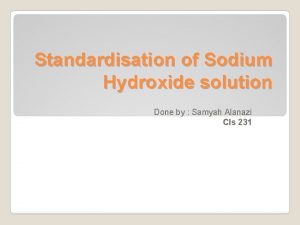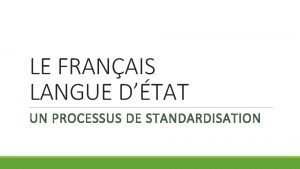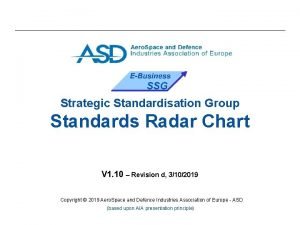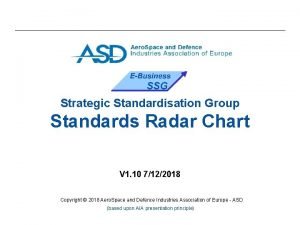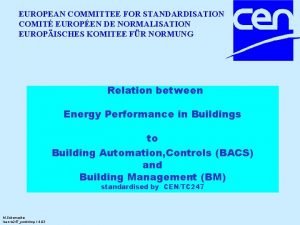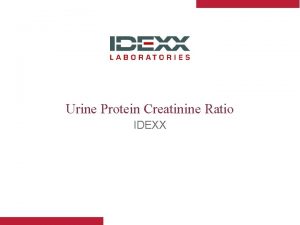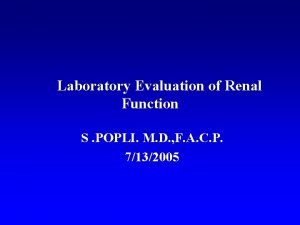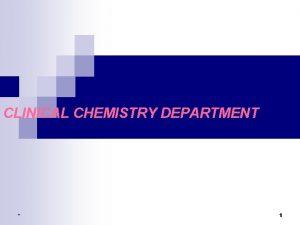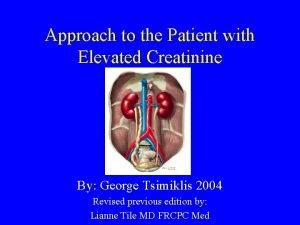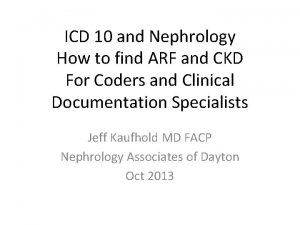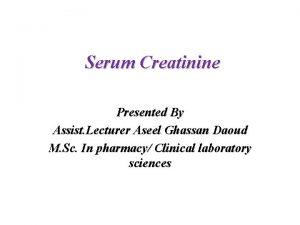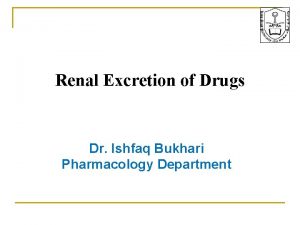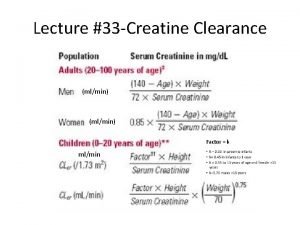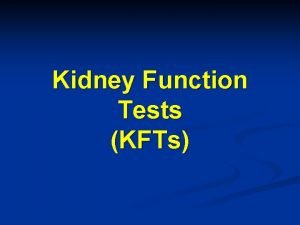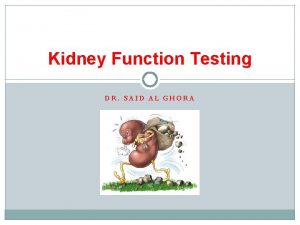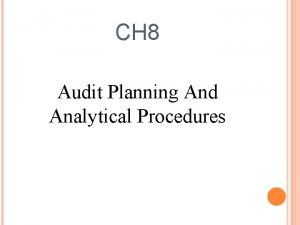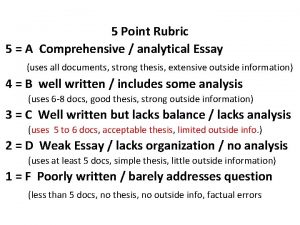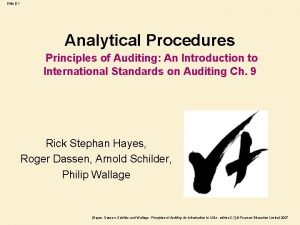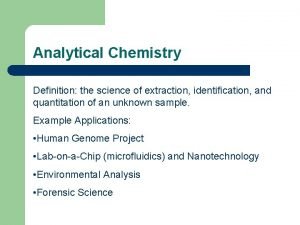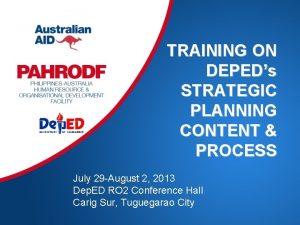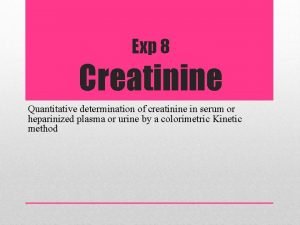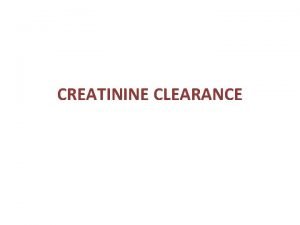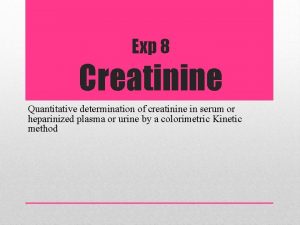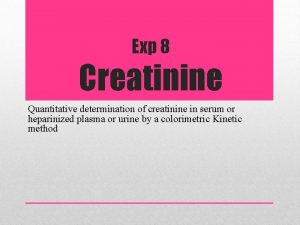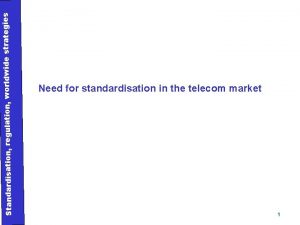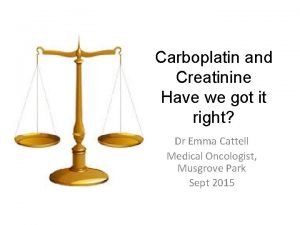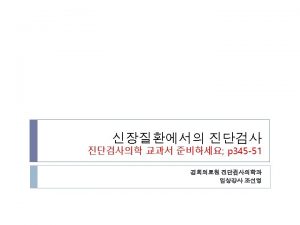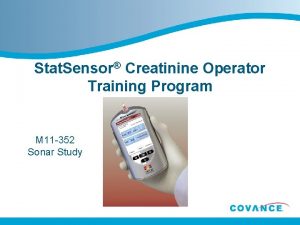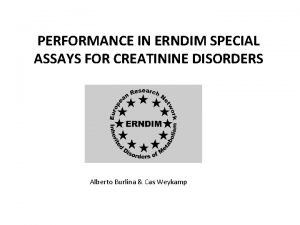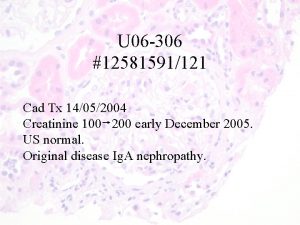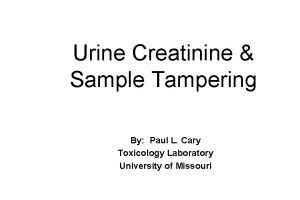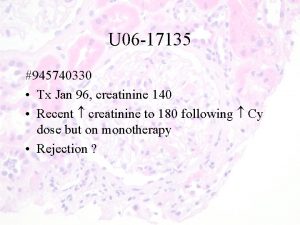ANALYTICAL AND CLINICAL EFFECTS OF CREATININE STANDARDISATION Prof




























![Cystatin C vs. creatinine • Advantages: • 1/[Cys C] ~ GFR • independent from Cystatin C vs. creatinine • Advantages: • 1/[Cys C] ~ GFR • independent from](https://slidetodoc.com/presentation_image_h/e18621bc750f9d65517e7f179b9a3c08/image-29.jpg)











- Slides: 40

ANALYTICAL AND CLINICAL EFFECTS OF CREATININE STANDARDISATION • Prof. J. Delanghe, MD, Ph. D • Dept. Clinical Chemistry • Ghent University 1

2

Creatinine according to Jaffe…. • Analysis following deproteinisation • pseudochromogens time window • Lloyds’s reagent • optimalisation • extremely cheap 3

Jaffe reaction 4

VARIATION BETWEEN METHODGROUPS 5

Variability in Jaffé’s method (I) (Hanser et al, Ann Biol Clin 2001; 59: 737 -42) 6

7

Technical evolution • 1954 Skeggs: dialysis membrane • 1970 centrifugal analyzer→ no longer dialysis step!→ protein error introduced • 1980 random acess analyzer 8

9

The protein error got into the determination! • 1970 - 2000: Jaffé rules the creatinine market in Europe and VS • Protein error leads to underestimation of GFR! (Cr. Cl << GFR) • some enzymatical determinations recalculated to Jaffé-equivalence! 10

What happened with creatinine? • Protein error got into the determination! • Only ref. values were adapted!!!! • Physiology books, derived formulas, • pharmacokinetics? ? ? 11

Pseudochromogens • Enzymatic methods theoretically eliminate effect of pseudochromogens • Not widely used (cost price) 12

Creatinine clearance • urine collection often difficult in practice • Intra individual CV 10 % • practical formulas: • e. g. Cockroft & Gault Nephron 1976; 16: 31 -41 13

14

15

COCKROFT & GAULT Cl = (140 -L) (year) x W(kg) S (mg/dl) x 72 for women result x 0. 85 MDRD (classical) GFR (m. L/min/1. 73 m 2) = 186 x (Scr)-1. 154 x (Age)-0. 203 x (0. 742 if female) x (1. 210 if African American) SCHWARTZ practical in children and infants GFR (ml/min/1. 73 m 2) = 0. 55 x L (cm)/P (mg/dl) (Pediatrics 1976; 58: 259) 16

7. 12. 2003 CE GUIDELINES • CE Guideline 98/79/EG on in-vitro diagnostics • PROBLEMS: • Calibration using standard of “higher order” • link with literature? • What with derived calculations? 17

18

REALITY AND THEORY IN DISAGREEMENT! 19

20

Creatinine in children 21

22

23

CREATININE IN CHILDREN 24

25

26

Clinical impact of a change in Cr. Cl, reference range • Fields of potential risk • drugs eliminated by renal excretion aminoglycosides/glycopeptides/carboplatine • Important for borderline Clcr for antibiotics • management for some antineoplastic agents • for clinical trials 27

LOOKING INTO THE FUTURE 28
![Cystatin C vs creatinine Advantages 1Cys C GFR independent from Cystatin C vs. creatinine • Advantages: • 1/[Cys C] ~ GFR • independent from](https://slidetodoc.com/presentation_image_h/e18621bc750f9d65517e7f179b9a3c08/image-29.jpg)
Cystatin C vs. creatinine • Advantages: • 1/[Cys C] ~ GFR • independent from muscle mass, diet • urinary determination not needed • valuable in the “blind range” zone of creatinine 29

NIST SRM 967 • Commutable reference material • Submitted bij JCTML • IDMS • 0. 8 mg/dl • 4 mg/dl • Revised MDRD • Release postponed!! 30

• PREPARATION OF SRM 967 CREATININE IN HUMAN SERUM • • • • • Prepared at Solomon Park Research Institute, Kirkland, Washington Human serum with the following characteristics: Master Pool comprised of units drawn from postmenopausal female donors to yield pool with creatinine of 0. 8 mg/d. L or lower. Collected and handled following NCCLS C 37 -A All units tested and found negative for viral markers Pooled and split into 2 sub-pools: Low level, High level, second sub-pool spiked with crystalline creatinine to bring the concentration to 4. 0 mg/d. L. LC/MS METHOD FOR SERUM CREATININE [P. Stokes, G. O’Connor, J Chromatog B 794, 125 -136 (2003)] Spike serum with creatinine-d 3, Precipitate proteins with cold ethanol, Centrifuge, Decant supernatant and dry under nitrogen Reconstitute in water and filter, Dilute with 10 m. M NH 4 acetate LC/MS Phenomenex LUNA C-18; Gradient: 10 m. M NH 4 acetate for 7 min, Then acetonitrile: 10 m. M NH 4 acetate (80: 20) and hold for 13 min Electrospray ionization – positive mode monitoring (M+H)+ at 31 114/117

NIST SRM 967 • 2006 -2009: Adaptation by IVD industry • 2010: problem solved? • In the mean time MDRD is pushing!!!! • Risks for confusion ! 32

Some Statistics (United States) • • End-stage renal disease (ESRD) Prevalence (2003): 452, 957 U. S. residents were under treatment • • Resulting from these primary diseases: Diabetes: 165, 113 Hypertension: 109, 642 Glomerulonephritis: 74, 444 Cystic kidney: 20, 409 All other: 83, 349 • • Number of kidney transplants performed 2003: 16, 043 2000: 14, 557 1995: 12, 021 1990: 10, 012 1988: 7, 501 33

• MDRD: THE SOLUTION? ? • Limitations (age, Cr. Cl value, ethnicity, . . ) • Confusion still ungoing • “Some unwanted side effects” • Drug dosage schemes! • Pediatrics? 34

• Conventional Calibration MDRD Equation • This equation should be used only with those creatinine methods that have not been recalibrated to be traceable to IDMS. If you have any question about the traceability of the calibration for the method, NKDEP recommends that you contact the reagent and/or calibrator manufacturer for assistance. • The equation requires 4 variables: • Serum, or plasma, creatinine (Scr) • Age in years (18 years or older) • Sex • Race (African American or not) • When Scr is in mg/d. L (conventional units): GFR (m. L/min/1. 73 m 2) = 186 x (Scr)-1. 154 x (Age)-0. 203 x (0. 742 if female) x (1. 210 if 35 African American)

CONFUSION…… • Conventional Calibration MDRD Equation • should be used only with those creatinine methods that have not been recalibrated to be traceable to IDMS. For more information, visit NKDEP's Laboratory Professionals section. • GFR (m. L/min/1. 73 m 2) = 186 x (Scr)-1. 154 x (Age)-0. 203 x (0. 742 if female) x (1. 210 if African American) (conventional units) • IDMS-Traceable MDRD Equation • should be used only with those creatinine methods that have been recalibrated to be traceable to IDMS. For more information, visit NKDEP's Laboratory Professionals section. • GFR (m. L/min/1. 73 m 2) = 175 x (Scr)-1. 154 x (Age)-0. 203 x (0. 742 if female) x (1. 210 if African American) (conventional units) 36

37

• IDMS-Traceable MDRD Equation • This equation should be used only with those creatinine methods that have been calibrated to be traceable to IDMS. If you have any question about the traceability of the calibration for the creatinine method, NKDEP recommends that you contact the reagent and/or calibrator manufacturer for assistance. • • The equation requires 4 variables: Serum, or plasma, creatinine (Scr) Age in years (18 years or older) Sex Race (African American or not) When Scr is in mg/d. L (conventional units): GFR (m. L/min/1. 73 m 2) = 175 x (Scr)-1. 154 x (Age)0. 203 x (0. 742 if female) x (1. 210 if African American) 38

Conclusions (I) • Compensated Jaffé method results in a more correct approximation of GFR • Cockroft & Gault, MDRD : only valid for enzymatic or “compensated” methods • Schwartz formula not usable for compensated (or enzymatic) method!!! • Adaptation of reference values is insufficient !!!!! 39

CONCLUSIONS (II) • Careful when using nomograms for drug dosage! • Creatinine standardisation: situation is still confuse! Vigilance necessary • MDRD has limitations (Cr. Cl value, age, standardisation) which should be respected • Task for industry, laboratories, clinicians, pharmacists 40
 How is the solution done
How is the solution done Product adaptation examples
Product adaptation examples Processus de standardisation
Processus de standardisation Kaizen 7 steps
Kaizen 7 steps Property standardisation group
Property standardisation group Property standardisation group
Property standardisation group Standardisation vs adaptation in international marketing
Standardisation vs adaptation in international marketing European committee for standardisation
European committee for standardisation Rolling plan for ict standardisation
Rolling plan for ict standardisation Idexx urine protein creatinine ratio
Idexx urine protein creatinine ratio Creatinine clearance formula
Creatinine clearance formula Zero order elimination drugs
Zero order elimination drugs Bun/creatinine ratio low
Bun/creatinine ratio low Gfr formula
Gfr formula Bun creatinine ratio prerenal postrenal
Bun creatinine ratio prerenal postrenal Creatinine (enzymatic)
Creatinine (enzymatic) Approach to elevated creatinine
Approach to elevated creatinine Bun creatinine ratio prerenal postrenal
Bun creatinine ratio prerenal postrenal Icd 10 prerenal azotemia
Icd 10 prerenal azotemia Normal bun
Normal bun Creatinine
Creatinine Clerance creatinine
Clerance creatinine Clearance is
Clearance is Clerance creatinine
Clerance creatinine Creatinine formula
Creatinine formula Creatinine level
Creatinine level Creatinine clearance
Creatinine clearance Formation of creatine phosphate
Formation of creatine phosphate Strategy core concepts and analytical approaches
Strategy core concepts and analytical approaches Inductive analytical approach to learning
Inductive analytical approach to learning Audit planning and analytical procedures
Audit planning and analytical procedures 5 point rubric for essay
5 point rubric for essay Types of analytical procedures
Types of analytical procedures Inductive and analytical learning in machine learning
Inductive and analytical learning in machine learning Difference between descriptive and analytic epidemiology
Difference between descriptive and analytic epidemiology Descriptive vs analytical epidemiology
Descriptive vs analytical epidemiology How to calculate incidence rate example
How to calculate incidence rate example Audit planning and analytical procedures
Audit planning and analytical procedures Analytical chemistry definition
Analytical chemistry definition Communication styles in the workplace
Communication styles in the workplace Rational sequential and analytical strategizing
Rational sequential and analytical strategizing
